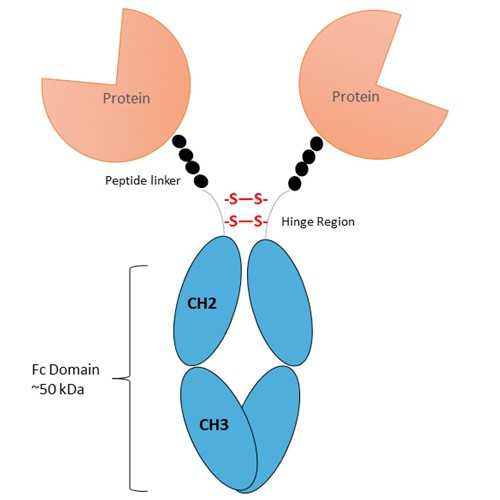Recombinant human SLAF7 Fc-Fusion Protein
Recombinant human SLAF7 Fc-Fusion Protein expressed in HEK293 cells.
Highlights:
- Prolongs of the plasma half-life (t1/2) of the protein of interest in vivo, resulting in improved therapeutic efficacy
- In vitro applications of Fc-Fusion proteins include immunohistochemistry (IHC), flow cytometry (FC), protein binding assays, and use as microarray baits
- Fc domain-Fusion can also improve the in vivo and in vitro solubility and stability of some binding partners
SLAM family member 7 (SLAF7) is a self-ligand receptor of the signaling lymphocytic activation molecule (SLAM) family. SLAM receptors triggered by homo- or heterotypic cell-cell interactions are modulating the activation and differentiation of a wide variety of immune cells and thus are involved in the regulation and interconnection of both innate and adaptive immune response. Activities are controlled by presence or absence of small cytoplasmic adapter proteins, SH2D1A/SAP and/or SH2D1B/EAT-2. Triggers cytolytic activity only in natural killer cells (NK) expressing high surface densities of natural cytotoxicity receptors. Positive signaling in NK cells implicates phosphorylation of VAV1. NK cell activation seems to depend on SH2D1B and not on SH2D1A. In conjunction with SLAMF1 controls the transition between positive selection and the subsequent expansion and differentiation of the thymocytic natural killer T (NKT) cell lineage. Promotes T-cell differentiation into a helper T-cell Th17 phenotype leading to increased IL-17 secretion; the costimulatory activity requires SH2D1A. Promotes recruitment of RORC to the IL-17 promoter. In conjunction with SLAMF1 and CD84/SLAMF5 may be a negative regulator of the humoral immune response. In the absence of SH2D1A/SAP can transmit negative signals to CD4+ T-cells and NKT cells. Negatively regulates germinal center formation by inhibiting T-cell:B-cell adhesion; the function probably implicates increased association with PTPN6/SHP-1 via ITSMs in absence of SH2D1A/SAP. However, reported to be involved in maintaining B-cell tolerance in germinal centers and in preventing autoimmunity.
From our sister company Absolute Antibody.
Recombinant human SLAF7 Fc-Fusion Protein expressed in HEK293 cells.
Highlights:
- Prolongs of the plasma half-life (t1/2) of the protein of interest in vivo, resulting in improved therapeutic efficacy
- In vitro applications of Fc-Fusion proteins include immunohistochemistry (IHC), flow cytometry (FC), protein binding assays, and use as microarray baits
- Fc domain-Fusion can also improve the in vivo and in vitro solubility and stability of some binding partners
SLAM family member 7 (SLAF7) is a self-ligand receptor of the signaling lymphocytic activation molecule (SLAM) family. SLAM receptors triggered by homo- or heterotypic cell-cell interactions are modulating the activation and differentiation of a wide variety of immune cells and thus are involved in the regulation and interconnection of both innate and adaptive immune response. Activities are controlled by presence or absence of small cytoplasmic adapter proteins, SH2D1A/SAP and/or SH2D1B/EAT-2. Triggers cytolytic activity only in natural killer cells (NK) expressing high surface densities of natural cytotoxicity receptors. Positive signaling in NK cells implicates phosphorylation of VAV1. NK cell activation seems to depend on SH2D1B and not on SH2D1A. In conjunction with SLAMF1 controls the transition between positive selection and the subsequent expansion and differentiation of the thymocytic natural killer T (NKT) cell lineage. Promotes T-cell differentiation into a helper T-cell Th17 phenotype leading to increased IL-17 secretion; the costimulatory activity requires SH2D1A. Promotes recruitment of RORC to the IL-17 promoter. In conjunction with SLAMF1 and CD84/SLAMF5 may be a negative regulator of the humoral immune response. In the absence of SH2D1A/SAP can transmit negative signals to CD4+ T-cells and NKT cells. Negatively regulates germinal center formation by inhibiting T-cell:B-cell adhesion; the function probably implicates increased association with PTPN6/SHP-1 via ITSMs in absence of SH2D1A/SAP. However, reported to be involved in maintaining B-cell tolerance in germinal centers and in preventing autoimmunity.
From our sister company Absolute Antibody.
For larger sizes, please Contact Us for a bulk discount.
| Product Type: | Protein |
| Alternative Name(s): | SLAM family member 7, CD2 subset 1, CD2-like receptor-activating cytotoxic cells, CRACC, Membrane protein FOAP-12, Novel Ly9, Protein 19A, CD319 |
| Accession ID: | Q9NQ25 |
| Antigen: | SLAF7 |
| Host: | HEK293 |
| Fc domain: | human IgG1 |
| Species: | human |
| Extinction Coefficient: | 137480 |
| Molecular Weight: | 99855.12 Da |
| Amino Acid Sequence: | SGPVKELVGSVGGAVTFPLKSKVKQVDSIVWTFNTTPLVTIQPEGGTIIVTQNRNRERVDFPDGGYSLKLSKLKKNDSGIYYVGIYSSSLQQPSTQEYVLHVYEHLSKPKVTMGLQSNKNGTCVTNLTCCMEHGEEDVIYTWKALGQAANESHNGSILPISWRWGESDMTFICVARNPVSRNFSSPILARKLCEGAADDPDSSMVLLCGGGGSEPKSQDKTHTCPPCPAPELLGGPSVFLFPPKPKDTLMISRTPEVTCVVVDVSHEDPEVKFNWYVDGVEVHNAKTKPREEQYNSTYRVVSVLTVLHQDWLNGKEYKCKVSNKALPAPIEKTISKAKGQPREPQVYTLPPSRDELTKNQVSLTCLVKGFYPSDIAVEWESNGQPENNYKTTPPVLDSDGSFFLYSKLTVDKSRWQQGNVFSCSVMHEALHNHYTQKSLSLSPGHHHHHH |
| Purity: | >95% (SDS-PAGE) |
| Buffer: | PBS + 0.02% Proclin 300 |
| Amount: | 0.1mg |
| Activity: | Self-ligand receptor of the signaling lymphocytic activation molecule (SLAM) family. SLAM receptors triggered by homo- or heterotypic cell-cell interactions are modulating the activation and differentiation of a wide variety of immune cells and thus are involved in the regulation and interconnection of both innate and adaptive immune response. Activities are controlled by presence or absence of small cytoplasmic adapter proteins, SH2D1A/SAP and/or SH2D1B/EAT-2. Isoform 1 mediates NK cell activation through a SH2D1A-independent extracellular signal-regulated ERK-mediated pathway [PMID:11698418]. Positively regulates NK cell functions by a mechanism dependent on phosphorylated SH2D1B. Downstream signaling implicates PLCG1, PLCG2 and PI3K [PMID:16339536]. In addition to heterotypic NK cells-target cells interactions also homotypic interactions between NK cells may contribute to activation. However, in the absence of SH2D1B, inhibits NK cell function. Acts also inhibitory in T-cells (By similarity). May play a role in lymphocyte adhesion [PMID:11802771]. In LPS-activated monocytes negatively regulates production of proinflammatory cytokines [PMID:23695528] [Uniprot]. |
| Mycoplasma Tested: | <1.0 EU/mg |
| Storage: | Store at 4C up to 1 month. Small volumes at -20C for longer storage. |
| Shipped: | Cold packs |
If you publish research with this product, please let us know so we can cite your paper.


